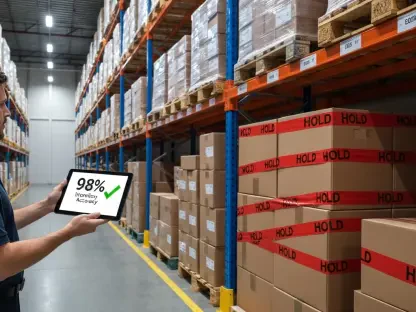The logistics sector has witnessed a remarkable digital transformation, paving the way for enhanced efficiency and streamlined operations. However, this evolution has also introduced a significant challenge—rising cyber threats. As the sector integrates more digital technologies and increasingly intricate supply chains, it becomes highly susceptible to cyber attacks. Almost 45% of supply chains are projected to operate autonomously by the next decade, amplifying the need for robust cyber security measures. Between July 2024 and July 2025 alone, there were 27 cyber incidents in the transportation and logistics domain, highlighting the sector’s heightened vulnerability.
Evolving Cyber Threat Landscape
Increasing Cyber Attacks
Research from Stenden University in the Netherlands underscored the imperative need for heightened security measures in the logistics industry. In 2013, there were a mere three cyber incidents reported in the shipping sector. By 2023, this number had alarmingly risen to 64, demonstrating a dramatic increase in cyber activities targeting the industry. Cyber attacks led to data breaches, operational downtimes, and overall disruptions in the logistics chain, pressuring industry leaders to bolster their defenses. The stakes are high, as these breaches can result in significant losses both in data integrity and financial stability.
The market for cyber security solutions in logistics is anticipated to expand considerably, with a compound annual growth rate of 12% from 2024 to 2037. This growth trajectory underscores the sector’s burgeoning focus on comprehensive security protocols. Prolific advancements in technology have further fueled this growth, accompanied by a substantial number of cyber security-related patents filed between 2024 and 2025. However, the mere proliferation of patents does not necessarily correspond to groundbreaking innovation, although it does indicate a concentrated effort towards industry resilience.
Financial Implications of Breaches
One of the most substantial impacts of cyber attacks is the financial cost associated with breaches. The IBM Cost of a Data Breach Report has highlighted a global average breach cost of USD 4.88 million in 2024, marking a 10% increase from the previous year. This underscores the critical need for logistics firms to invest in advanced security frameworks, which include encrypted data transmission and multi-factor authentication. Regular vulnerability assessments and penetration testing also play crucial roles in mitigating potential threats and ensuring network integrity.
Human error remains a predominant risk factor in cyber security breaches. Inadequate training and awareness often lead to employees falling prey to sophisticated phishing attacks, resulting in severe data breaches. The Cyber Management Alliance advocates for regular and comprehensive cyber security training programs to foster a culture of vigilance among employees. According to Randy Rose from the Centre for Internet Security, effective cyber security education can significantly curb the incidence of errors that may lead to substantial financial losses and compromised data integrity.
Technological Advances and Security Measures
Role of Patented Technologies
In the logistics sector, patented technologies like encryption and authentication protocols serve as vital tools for setting industry benchmarks and driving continuous innovation. These technologies promote knowledge sharing and enhance the overall security posture of the industry. Still, the sector remains a prime target for cyber criminals who exploit existing vulnerabilities to orchestrate breaches and operational disruptions. Given the high stakes, adopting best practices in cyber security is essential for logistics companies aiming to protect proprietary data and maintain uninterrupted operations.
The logistics industry also relies extensively on Internet of Things (IoT) devices, which enable real-time monitoring and enhance operational efficiencies. However, the integration of IoT devices introduces additional layers of vulnerabilities, making it imperative to secure the entire IoT infrastructure. Companies must enforce stringent security measures, including regular audits and secure data transmission protocols, to safeguard against potential threats. Ensuring the security of both in-house systems and those of third-party partners and suppliers is critical for maintaining a resilient supply chain.
Real-Time Threat Monitoring
Real-time threat monitoring has emerged as an indispensable practice in the logistics sector’s cyber security strategy. Detecting irregular network activities promptly allows companies to mitigate potential threats before they escalate into significant security breaches. Employing advanced analytics and monitoring tools is vital for a proactive and responsive security posture. This continuous vigilance ensures that any suspicious activities are addressed immediately, thereby minimizing the risk of data loss and operational disruptions.
Implementing layered security frameworks is essential to counteract sophisticated cyber attacks. These frameworks encompass various security measures, including firewalls, advanced encryption techniques, and multi-factor authentication. Robust security protocols not only enhance data protection but also build trust among stakeholders within the supply chain. Regular vulnerability assessments further strengthen security measures, enabling logistics companies to identify and rectify weak points in their digital infrastructure.
The Road Ahead
The logistics sector has undergone an impressive digital transformation, leading to improved efficiency and streamlined operations. Yet, this progress has also brought about a significant challenge: the rise of cyber threats. With the integration of advanced digital technologies and increasingly complex supply chains, the industry is becoming more vulnerable to cyber attacks. It is forecasted that by the next decade, nearly 45% of supply chains will operate autonomously, underscoring the critical need for strong cyber security measures. An example of this trend is evident when looking at the period from July 2024 to July 2025, where the transportation and logistics sector faced 27 cyber incidents, clearly demonstrating the sector’s increased susceptibility to cyber threats. As the industry continues to evolve digitally, bolstering cyber security will be essential in ensuring the continued smooth and secure operation of supply chains across the globe.









